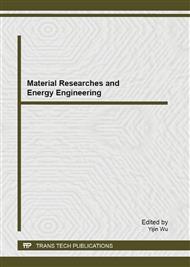[1]
A.S. Ardeleanu., M. Cretu and C. Donciu: Proceedings of 7th International Conference on Management of Technological Changes vol. 2 (2011), p.553.
Google Scholar
[2]
G.W. Hart: Proceedings of the IEEE vol. 80 (1992), p.1870.
Google Scholar
[3]
H.H. Chang, C.L. Lin and J.K. Lee: Proceeding of the 14th International Conference on Computer Supported Cooperative Work in Design (2010), p.27.
Google Scholar
[4]
U.A. Khan S.B. Leeb and M.C. Lee: IEEE Transactions on Power Delivery vol. 12 (1997), p.51.
Google Scholar
[5]
S.B. Leeb and J.L. Kirtley: Proceedings of the IECON vol. 1 (1993), p.354.
Google Scholar
[6]
L.K. Norford and S.B. Leeb: Energy and Buildings vol. 24 (1996), p.51.
Google Scholar
[7]
A.I. Cole and A. Albicki: Proceedings of the IEEE instrumentation and measurement technology conference (2000), p.24.
Google Scholar
[8]
C. Laughman, K. Lee, R. Cox, S. Shaw, S. Leeb S., L. Norford and P. Armstrong: IEEE Power and Energy Magazine vol. 1 (2003), p.56.
DOI: 10.1109/mpae.2003.1192027
Google Scholar
[9]
K.D. Lee, S.B. Leeb, L.K. Norford, P.R. Armstrong, J. Holloway and S.R. Shaw: IEEE Transactions on Energy Conversion vol. 20 (2005), p.566.
DOI: 10.1109/tec.2005.852963
Google Scholar
[10]
S.R. Shaw, S.B. Leeb, L.K. Norfold and R.W. Cox: IEEE Transactions on Instrumentation and Measurement vol. 57 (2008), p.1445.
Google Scholar
[11]
D. Srinivasan, W.S. Ng and A.C. Liew: IEEE Transactions on Power Delivery vol. 21 (2006), p.398.
Google Scholar
[12]
W. Wichakool, A.T. Avestruz, R.W. Cox and S.B. Leeb: IEEE Transactions on Power Electronics vol. 24 (2009), p.2803.
DOI: 10.1109/tpel.2009.2029231
Google Scholar
[13]
J. Liang, S.K.K. Ng, G. Kendall and J.W.M. Cheng: IEEE Transactions on Power Delivery vol. 25 (2010), p.551.
Google Scholar
[14]
J. Liang, S.K.K. Ng, G. Kendall and J.W.M. Cheng: IEEE Transactions on Power Delivery vol. 25 (2010), p.561.
Google Scholar
[15]
S.N. Patel, T. Robertson, J.A. Kientz, M.S. Reynolds and G.D. Abowd: Proceedings of the 9th International Conference on Ubiquitous computing (2007), p.271.
Google Scholar
[16]
A.S. Ardeleanu and C. Donciu: Proceedings of 2012 International Conference and Exposition on Electrical and Power Engineering (2012), p.792.
Google Scholar


